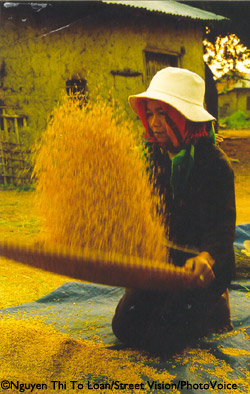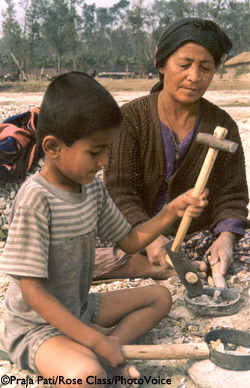Susan Ridley - PHOTOVOICEPhotoVoice’s methodolgy was designed for disadvantaged and marginalized groups, and blends a grassroots approach to photography and social action. Cameras are provided to the people with the least access to those who make decisions that affect their lives, giving them the opportunity to define themselves. PhotoVoice has been used in many research projects in social action reform, healthcare and education including autism, child welfare, homelessness, immigration, student advocacy, nursing, drug education, mother's with learning difficulties, women's health and as a strategy for community change. The PhotoVoice concept was developed by Caroline C. Wang and Mary Ann Burris in 1998 while they were both studying for MA’s in Social Anthropology at Edinburgh University, UK. Both had a background and interest in documentary photojournalism and integrated participatory photography into their MA dissertations, independently establishing the Street Vision Project in Vietnam and the Children’s Forum Project in Nepal.
PhotoVoice GoalsPhotoVoice has three main goals (a) to enable people to record and reflect their community's strengths and concerns, (b) to promote critical dialogue and knowledge about personal and community issues through large and small group discussions of photographs, and (c) to reach policy makers.
PhotoVoice Methodology (Wang, 1999) 1. Select and recruit a target audience of policymakers or community leaders. 2. Recruit a group of PhotoVoice participants. 3. Introduce the PhotoVoice methodology to the participants and facilitate a group discussion. 4. Obtain informed consent. 5. Pose an initial theme for taking pictures. 6. Distribute cameras to participants and review how to use them. 7. Provide time for participants to take pictures. 8. Meet to discuss photographs. 9. Plan with participants a format to share photographs and stories with policymakers or community leaders. PhotoVoice Review
PhotoVoice is a participatory action research method that has proven to be a successful way of empowering groups that have traditionally been underrepresented, labeled or stigmatized. The use of photographs (visual imagery) and stories (personal insights) are a powerful combination that can give voice to participants regardless of social status, age, race, ethnicity, sexual orientation and physical or mental wellness. PhotoVoice has been used in a wide range of geographical and cultural environments. It is a strong advocacy tool, a community education strategy and a tool for social change. It is an effective way to involve community participation in local health efforts to address issues and unmet needs identified by participants (Pies & Parthasarathy, n.d.). For Booth and Booth: The process challenges the established politics of representation by shifting the means of documenting lives from the powerful to the powerless, the expert to the lay person, the professional to the client, the bureaucrat to the citizen, the observer to the observed (2003, p. 432).
Wang (1999) identified five key concepts that united research groups utilizing the PhotoVoice technique (a) images that teach, (b) pictures can influence policy, (c) community participation in creating and defining the images that can shape public health policy, (d) involvement of policymakers or community leaders, and (e) PhotoVoice emphasized individual and community action (p. 186-187).
Opportunities The old adage that a picture speaks a thousand words illustrates the power of visual imagery to transcend language, a divide that often creates miscommunication or a barrier to understanding. Words have different meanings between races or ethnicities and cultures. Words can also be a barrier for those suffering from learning difficulties. In a PhotoVoice study involving children with autism, the decreased reliance on verbal communication and focus on visual imagery increased engagement and attention to learning materials (Carnahan, 2006). For urban youth in a literacy program, the visual imagery was a powerful tool in helping them write descriptive and analytical paragraphs (Zenkov & Harmon, 2009).
Participation in PhotoVoice may foster a change in the participant’s view of themselves; from non-influential to influential (Bell, 2009). It also provided an opportunity for community participants to engage in the process of collecting data, analyzing results and offering solutions (Goodhart et al, 2006; Streng et al, 2004).The visual images are a permanent documentation that can be analyzed to generate themes that can often lead to social action around identified problems. These images can then be used in the future to document change (Sharma, 2010). Challenges PhotoVoice is a qualitative study that is subjective in nature. Not all participants in a PhotoVoice project may be willing to discuss their thoughts, feelings and attitudes (Dixon & Hadjialexiou, 2005) or open themselves up to public scrutiny (Booth & Booth, 2003; Wang, 2006). Given the slow pace of change, it may also be difficult to quantify the degree that PhotoVoice impacted program improvements or policy change within a set timeframe (Wang & Pies, 2004).
Conclusion PhotoVoice is not just about taking photographs. Its value is also in the discussions that it generates and the insight it garners through creative writing. It has a proven track-record across cultures and geographical locations as a tool in raising awareness regarding social and health issues. As an Expressive Arts Therapist I find PhotoVoice to be a powerful community-based participatory research method which creatively engages participants in the process of problem-solving identified needs. I was so impressed by the process that I will incorporate PhotoVoice into my dissertation topic - Spirituality and Expressive Arts: A Search for Identity, Meaning and Purpose. My pilot study was an arts-based research project involving parents and teens. The study was divided into three research stages (a) expressive arts therapy groups that decorated mirrors around the question of identity, (b) an exhibition of the mirrors open to the general public, and (c) a high school freshman exhibition that highlighted specific mirrors. For the dissertation I will continue this investigation with an intergenerational mirror project involving senior residents and teens to look at changes in identity; senior residents moving from independence to dependence of old age and teens moving from dependence to independence of adulthood. The PhotoVoice project will be introduced to look at the meaning and purpose of life for participants. I am inclined to make the project intergenerational and include both seniors residents and teens to look at themes and values associated with a life full of accomplishments vs. a life full of hope and dreams. The inclusion of PhotoVoice in my dissertation will provide a rich source of insight and visual imagery on these fundamental questions; Who am I? Why am I here? What is my purpose in life? PhotoVoice provides a clear methodology which will be replicated in my research study involving senior residents and senior high school students. The intent is to add another layer of enquiry which will include a questionnaire for participants around attitudes to each other and whether participating in the PhotoVoice project has changed those attitudes. Generally senior residents have a low view of teens and vice versa. The hope is that in working together, and in identifying similar values and concerns these two misunderstood groups will gain insight and value each other’s contribution to the community. The project will be called Senior's Challenging Senior's: Bridging the Generation Gap. In addition, an exhibition survey will be created for those viewing the PhotoVoice project (once it is completed) to gather feedback and also to provide an opportunity for the audience to reflect on their own values and purpose in life. PhotoVoice has a proven track record in raising awareness and in social action. It is a dynamic tool and I look forward to creating this project once my qualifying papers are completed and approval for dissertation is achieved. References Bell, S. E. (2009). Photovoice as a strategy for community organization in the Central Appalachian Coalfields. Journal of Appalachian Studies, 14(1 & 2), 34-48. Retrieved from http://www.appalachianstudies.org/jas/ Booth, T., & Booth, W. (2003). In the frame: Photovoice with mothers with learning difficulties. Disability & Society, 18(4), 431-442. doi:10.1080/0968759032000080986 Carnahan, C. (2006). Photovoice: Engaging children with Autism and their teachers. Teaching Exceptional Children, 39(2), 44-50. Retrieved from http://www.cec.sped.org/Content/NavigationMenu/Publications2/TEACHINGExceptionalChildren/default.htm Dixon, M., & Hadjialexiou, M. (2005). Photovoice: Promising practice in engaging young people who are homeless. Youth Studies Australia, 24(2), 52-56. Retrieved from http://www.acys.info/journal Goodhart, F. W., Hsu, J., Coleman, A. L., Maresca, F., & Miller, M. B. (2006, July/August). A view through a different lense: Photovoice as a tool for student advocacy. Journal of American College Health, 55, 53-56. Retrieved from http://www.acha.org/Publications/JACH.cfm Pies, C., & Parthasarathy, P. (n.d.). Photovoice: Giving local health departments a new perspective on community health issues. Contra Costa Health Services, 1-8. Retrieved from http://www.cchealth.org/topics/community/photovoice Sharma, M. (2010). Editorial: Photovoice in alcohol and drug education. Journal of Alcohol and Drug Education, 1-5. Retrieved from http://findarticles.com/p/articles/mi_go2545/ Streng, J. M., Rhodes, S. D., Ayala, G. X., Eng, E., Arceo, P., & Phipps, S. (2004). Realidad Latina: Latino adolescence, their school, and a university use Photovoice to examine and address the influence of immigration. Journal of Interprofessional Care, 18(4), 403-415. doi:10-1080/13561820400011701 Wang, C. C. (1999). Photovoice: A participatory action research strategy applied to women’s health. Journal of Women’s Health, (8)2, 185-192. Retrieved from http://www.liebertpub.com/Products/Product.aspx?pid=42 Wang, C. C., Pies, C. A. (2004). Family, maternal, and child health through Photovoice. Maternal and Child Health Journal, 8(2), 95-102. doi:1092-7875/04/0600-0095/0 Wang, C. C. (2006). Youth participation in Photovoice as a strategy for community change. Journal of Community Practice, 14(1/2), 147-161. doi:10-1300/J125v14n01_09 Zenkov, K., & Harmon, J. (2009). Picturing a writing process: Photovoice and teaching writing to urban youth. Journal of Adolescence & Adult Literacy, 52(7), 575-584. doi:10.1598/JAAL.52.7.3 |
||||||||||||||||||||||
|
|
|||||||||||||||||||||


